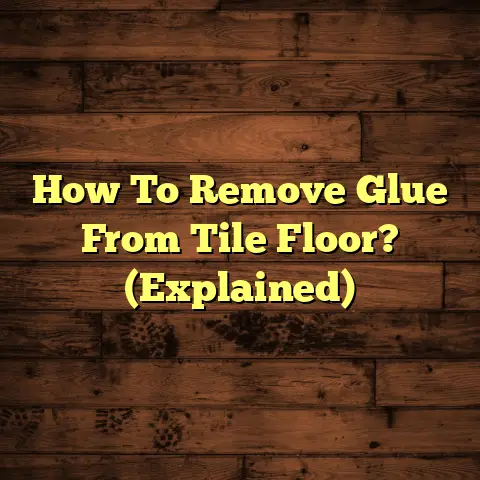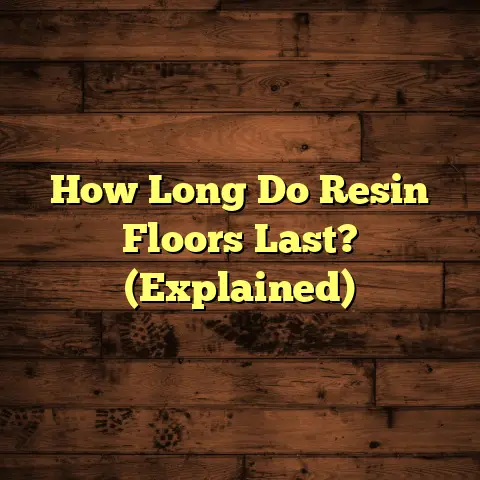Uneven Floors in Old Houses: Normal? (1 Quick Fix!)
Ever stop and think about how your home shapes your day?
I mean, really think about it.
Does the creak of the stairs tell you someone’s awake?
Does the afternoon sun streaming through the wavy glass windows fill you with a sense of peace?
Living in an older home is a unique experience, isn’t it?
We’re surrounded by character, by history.
But sometimes, that character comes with…challenges.
Like, say, an uneven floor.
Have you ever tripped on a floorboard that’s a little higher than the one next to it?
Or felt a slight tilt while walking across the living room?
It’s a common quirk in old houses, but is it something to worry about?
Should you just embrace it, or is it a sign of bigger problems?
Well, that’s exactly what we’re going to explore today.
I’ll share my insights as a seasoned flooring contractor, and we’ll even look at a quick fix you can try!
Section 1: Understanding Uneven Floors
Okay, let’s get down to brass tacks.
What exactly is an uneven floor?
Simply put, it’s a floor surface that isn’t perfectly level or flat.
You might notice dips, humps, or slopes as you walk across it.
Now, there are several reasons why this happens, especially in older homes.
The Usual Suspects
- Settling: Over time, the ground beneath a house shifts and compacts.
This is natural, but it can cause the foundation to settle unevenly, which then affects the floors above. - Age-Related Wear: Let’s face it, older homes have seen a lot of action!
Decades of foot traffic, furniture, and just the simple passage of time can wear down flooring materials, creating uneven surfaces. - Environmental Factors: Moisture is a big culprit.
Water damage from leaks, floods, or even just high humidity can warp wood floors and damage subflooring, leading to unevenness. - Foundation Issues: Cracks or deterioration in the foundation can cause significant shifting and settling, leading to very noticeable unevenness.
- Subfloor Problems: The subfloor, that layer between the joists and your finished floor, can sag, rot, or become damaged by pests, resulting in an uneven surface above.
- Poor Initial Construction: Sometimes, let’s be honest, the original construction wasn’t perfect to begin with.
Maybe the floor joists weren’t properly leveled, or the subfloor wasn’t installed correctly.
Architectural Styles and Uneven Floors
Believe it or not, the architectural style of your old home can actually predispose it to uneven floors.
For example, homes built on piers or stilts are more susceptible to settling than those with solid foundations.
Similarly, balloon-framed houses (common in the 19th century) can be more prone to movement and shifting over time.
Knowing the architectural history of your home can give you clues about why your floors might be uneven.
The Emotional Side of Uneven Floors
Okay, I know this might sound a little strange, but let’s talk about the feelings associated with uneven floors.
For some homeowners, they’re a charming quirk, a reminder of the home’s history and character.
They add a sense of warmth and authenticity that you just can’t get in a new build.
But for others, uneven floors are a source of frustration.
They can be a tripping hazard, make it difficult to arrange furniture, and even just feel…wrong.
It really comes down to personal preference and how much the unevenness affects your daily life.
Section 2: Identifying the Problem
Alright, let’s get practical. How do you actually know if you have uneven floors?
Here’s a step-by-step guide:
- The Eyeball Test: Start by simply looking at your floors.
Can you see any obvious dips, humps, or slopes? - The Rolling Test: Grab a marble or a small ball and place it on the floor.
Does it roll in a particular direction?
If so, that indicates a slope. - The Level Test: Use a level (a long one is best) to check for unevenness.
Place the level on the floor and see if the bubble is centered.
If it’s off to one side, the floor is uneven. - The Feeling Test: Walk barefoot across your floors.
Can you feel any differences in height or texture? - The Water Test: Pour a small amount of water on the floor.
Does it pool in certain areas?
This can indicate low spots.
Warning Signs: When Uneven Floors Signal Bigger Problems
Sometimes, uneven floors are just a minor annoyance.
But other times, they can be a sign of more serious underlying issues.
Here are some red flags to watch out for:
- Cracks in Walls: Cracks, especially those around doors and windows, can indicate foundation movement.
- Doors That Stick: If doors are suddenly difficult to open or close, it could be a sign that the house is shifting.
- Gaps in Windows: Similar to sticking doors, gaps around windows can indicate structural problems.
- Visible Foundation Damage: Obvious cracks, crumbling, or shifting in the foundation are a major cause for concern.
- Significant Sloping: If the floors slope dramatically, it’s a sign of serious settling or structural damage.
If you notice any of these warning signs, it’s important to consult with a qualified contractor or structural engineer.
Real-Life Experiences
I’ve seen it all in my years as a flooring contractor.
I remember one homeowner, Sarah, who had a beautiful Victorian home.
She loved the character of the house, but she was constantly tripping on a particularly uneven spot in her hallway.
“It was charming at first,” she told me, “but after a while, it just became a hazard.
I was worried someone would get seriously hurt.”
After inspecting her floors, I discovered that the subfloor in that area had been damaged by water, causing it to sag.
We were able to repair the subfloor and level the floor, making her home both beautiful and safe.
On the other hand, I’ve also worked with homeowners who embrace the unevenness of their floors.
They see it as part of the home’s story, a reminder of the people who lived there before them.
It’s all about perspective, really.
Section 3: Is it Normal?
Okay, the million-dollar question: Is it normal for old houses to have uneven floors?
The short answer is: Yes, it’s very common.
In fact, I’d say that most old houses have some degree of unevenness in their floors.
According to the National Association of Home Builders (NAHB), the average home settles about one inch for every 100 feet.
However, older homes can settle significantly more than that, especially if they haven’t been properly maintained.
Historical Context
To understand why uneven floors are so common in old houses, you have to consider the historical context of home construction.
In the past, building materials weren’t as consistent or precise as they are today.
Lumber might not have been perfectly straight, and foundations might not have been as solid.
Additionally, building codes and standards were less stringent, so there was more room for error.
Over time, these factors can contribute to uneven floors.
Expert Opinions
I’m not the only one who thinks uneven floors are normal in old houses.
Many experts agree that it’s simply a part of the aging process.
“Uneven floors are a common characteristic of older homes,” says Bob Vila, the renowned home improvement expert.
“They’re often a result of settling, age-related wear, and changes in humidity.”
However, it’s important to remember that some unevenness is normal, while excessive unevenness can be a sign of a more serious problem.
If you’re concerned about the condition of your floors, it’s always best to get a professional opinion.
Section 4: The Quick Fix
Alright, let’s get to the good stuff.
I’m going to share a “quick fix” for minor unevenness in floors.
Now, I want to be clear: This isn’t a solution for major structural problems.
If you have significant sloping or foundation issues, you’ll need to consult with a professional.
But for small dips and humps, this quick fix can make a noticeable difference.
The Shim Solution
The basic idea is to use shims to level out the floor.
Shims are thin, tapered pieces of wood that can be inserted under the flooring to raise it up.
Materials You’ll Need:
- Shims (available at most hardware stores)
- Wood glue
- Utility knife
- Hammer
- Level
Safety Precautions:
- Wear safety glasses to protect your eyes from flying debris.
- Use caution when using a utility knife.
- If you’re working in a dusty area, wear a dust mask.
Step-by-Step Guide:
- Locate the Low Spots: Use a level to identify the areas where the floor is uneven.
Mark these spots with a pencil. - Prepare the Shims: Apply a small amount of wood glue to one side of a shim.
- Insert the Shim: Carefully insert the shim under the flooring at the low spot.
You may need to gently pry up the flooring with a screwdriver or putty knife to create enough space. - Adjust the Shim: Use a hammer to gently tap the shim into place.
Check the level to see if the floor is now level.
If not, adjust the shim as needed. - Trim the Shim: Once the floor is level, use a utility knife to trim off any excess shim that is sticking out.
- Repeat as Needed: Repeat these steps for all the low spots in the floor.
Practical Tips
- Start Small: Don’t try to level the entire floor at once.
Focus on the most noticeable low spots first. - Use Multiple Shims: If the gap is too large for a single shim, use multiple shims stacked on top of each other.
- Be Patient: Leveling a floor can take time and patience.
Don’t get discouraged if it doesn’t look perfect right away. - Consider the Flooring Type: This quick fix works best with hardwood floors or laminate flooring.
It may not be suitable for tile or other types of flooring.
Before-and-After
I’ve used this quick fix in countless homes, and the results can be quite dramatic.
I remember one client who had a noticeable dip in her living room floor.
It was only about a quarter of an inch, but it was enough to make her furniture wobble.
After spending an hour or two shimming the floor, the dip was gone.
She was amazed at the difference it made.
“It’s like a whole new room!” she exclaimed.
Potential Costs
The cost of this quick fix is relatively low.
Shims typically cost only a few dollars per pack.
You may already have wood glue, a utility knife, and a hammer on hand.
If not, you can purchase them at most hardware stores for a reasonable price.
The biggest cost is your time and effort.
Section 5: Embracing the Quirks of Old Homes
Look, I get it.
Uneven floors can be frustrating.
But I also believe that they’re part of what makes old homes so special.
They tell a story, a story of the people who lived there before you, the events that shaped the house, and the passage of time.
Instead of trying to eliminate every imperfection, why not embrace the quirks of your old home?
Preserving History and Charm
When you renovate an old home, it’s important to strike a balance between practicality and preservation.
You want to make the home comfortable and safe to live in, but you also want to retain its historical character.
Sometimes, that means accepting certain imperfections, like uneven floors.
Decorating Around Uneven Floors
There are plenty of ways to decorate and arrange furniture in a way that accommodates uneven flooring.
Here are a few ideas:
- Use Rugs: Rugs can help to camouflage uneven spots and create a more level surface.
- Choose Furniture with Adjustable Feet: Furniture with adjustable feet can be leveled even on uneven floors.
- Embrace the Imperfection: Don’t try to hide the unevenness.
Instead, highlight it with interesting décor or artwork. - Create Focal Points: Draw attention away from the floors by creating focal points in the room, such as a fireplace or a large piece of art.
Conclusion
So, are uneven floors normal in old houses?
Absolutely.
They’re a common characteristic of older homes, a result of settling, age-related wear, and other factors.
While excessive unevenness can be a sign of a more serious problem, minor dips and humps are usually nothing to worry about.
And as we discussed, there’s a quick fix you can try for minor issues!
In fact, they can even add to the charm and character of your home.
So, embrace the quirks, appreciate the history, and enjoy your unique living space to the fullest.
After all, your home tells a story, and those uneven floors are just one chapter in that story.





